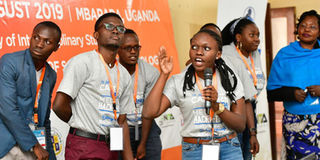Mutungi’s team developed a device to prevent low back pain

Innovation. The winning team, led by Lynette Mutungi (with microphone), pitch their idea at the 7th annual CAMTech Hack-a-thon competitions recently. PHOTO BY CHARLOTTE NINSIIMA
What you need to know:
- Solution. Lynette Mutungi, leader of the winning team at a recent innovation competition, says they identified low back pain as a major challenge faced by many nurses who carry heavy loads, including patients and equipment, writes Charlotte Ninsiima.
You only have five minutes to pitch your idea!” The moderator exclaimed at the 7th annual CAMTech Hack-a-thon competitions.
Sixty ideas were presented by students and health workers before five panellists. Teams later emerged, depending on individual interests, and seven made it to the semi-finals.
The groups worked under immerse pressure to exhibit a prototype aimed towards improving the nurse and midwife’s welfare. They were supposed to come up with solutions to any challenges faced by the health workers.
The teams worked around the clock and after a day and half, young scientists that had invented a ‘Lift Relief’ were announced winners and won the overall prize of $10,000 (Shs37m) at August 25 CAMTech competitions held on at Mbarara University of Science and Technology.
Lynette Mutungi, leader of the winning team, says they identified low back pain as a major challenge faced by many nurses who carry heavy loads, including patients and equipment, during the course of the day.
“Also, [the pains are caused by] long procedures that involve bending and inability to measure the weight of patients who can’t stand on their own. The team improvised a solution towards the problem to ease their [health workers’] working conditions,” she says.
Low Back Pain (LBP) is one of the issues that affect nurses and midwives during or after their duties. Globally, the frequency of LBP in nurses ranges from between 40 per cent and 97.9 per cent.
A study done amongst nurses at Kibuli hospital in Kampala shows that 84 per cent reported low back pain. And about 31 per cent have endured long term leave to have this issue worked upon.
Lift Relief
Led by Mutungi, a fourth-year student of biomedical engineer at Makerere University, the winning team comprised Edgar Atamba, Faith Agasha, Philip Twenyongyere, Erikan Baluku, Robert Ruhanga Ariyo, Parfait Harerimana and Dr Grace Nambozi who played a supervisory role.
“To seek solutions to mitigate the cause of the low back pain, the group developed a portable, cost-effective automatic patient lift. Lift Relief is a medical patient aid that automatically carries patients who can’t move on their own,” Mutungi explains, adding that it carries patients that are either critically ill or have been injured during accidents.
“The actual materials needed for the group’s prototype weren’t available, so we had to improvise. “We asked a carpenter to create stands and frame of the bed out of wood. To demonstrate, used wheels and circular pieces of rubber from slippers. We spent Shs65,000,” Mutungi says.
The machine is a patient trolley, or stretcher with wheels, with the bed surface connected to a technological device called linear actuator. It uses rods and is powered by electric mortar to enable vertical movements of the device.
“We hope to add linear actuators, placed in each of the poles so that they enable the bed move upwards or downwards to support up to 400kgs. They are either remote controlled or manually switched on. When one switches on the bed, it goes down, then slides the patient gently onto the device. It does this within 30 seconds while handling emergencies,” Mutungi says.
Benefits
“The soft canvas covering the bed can easily be cleaned, thus controlling the spread of infections in facilities. It benefits the patient by increasing comfort while lifting which reduces the risk of spinal injuries that occur during carrying.”
Mutungi says they aim at coming up with a functional prototype that applies their intended principle and will engage nurses so that their input can make the device better.
“We want to purchase the linear technologies to make an actual functional project, essentially a size of a normal stretcher,” she says.
For funding, they hope to partner with some innovation hubs around the country. She says the potential partners include Innovation Village, Resilient Africa Network, Red Cross, ministries of ICT and Health.
Challenges
Mutungi says the linear actuators are not available on the local market and so they have to import them.
About competition
Team Smart Nurse took the second position, followed by MEWs App and Life Band in the fourth position.
The Hack-a-thon competitions focus on developing innovations on medical technologies to support nursing and midwifery. Hack-a-thon is a space that brings together minds to develop innovative health solutions by identifying a problem, pitching and hacking the progress.
Data Santorino, the cauntry manager at the Consortium for Affordable Medical Technologies (CAMTech) says at the rate at which the world is developing, one can’t afford to do things the way they have always done it.




